Upper Rio Grand Watershed: Big Spring Creek
Monday, June 23, 2008
Friday, June 20, 2008
Southwest Exploration: A Timeline and Bibliography
The more I study ecology, the more I need to study history. Everything from the extinction of the paleolithic megafauna through the grenshorizont of peatland bog studies (shift in peat formation two to three thousand years ago as the midwest became wetter and cooler) to the presence or absence of bufalo (Bison bison bison) in the Arid West....Ecology is paleoecology, which is forensic and contingent on largely unknowable past events. But without that past the changing movie of life is only a single strobe, an event, a stained glass window that we can look at but now through. This perspective is important for science, but equally important for public policy. We can't protect what we've already forgotten.
Below is a partial list of early explorers and colonists of the American Southwest, especially New Mexico, which has a 500+ year written history. We desperately need an ecological historian to compile these original observations, translate and condense, collate, draw conclusions, and eventually inbed it all in a google earth kml layer, like the Mannahata project.
This is a New Mexico centric list, prepared with much help from to William Goetzmann http://www.nps.gov/history/history/categrs/explr/biblio-g2.htm and Ruth Marie Colville, "La Vereda: A Trail through Time."
1537 Cabeza de Baca seven year trek from Texas to Sea of Cortez, fording the Rio Grande "breast high".
Journal: unreliable "recounting"
Book: Cyclone Covey, ed. And trans., Cabeza de Vaca's Adventures in the Unknown Interior of America, Univ. of NM Press, Albuquerque, NM, 1993.
1540 Francisco Coronado two years exploring Rio Grande Valley as far north as Taos, east to Kansas, west [in]to the Grand Canyon.
Journal: ?
Book: Coronado, Knight of Pueblo and Plains, Univ. NM Press, by Herbert E. Bolton, Albuquerque, NM, 1964
Book:[?]Pedro de Castañeda, The Journey of Coronado, repr., Dover, San Francisco, 1990,
1580 Rodrigues expedition: Fray Augustin Rodrigues and Captain Francisco Chamuscada. Rio Grande valley east to Pecos River
Journal: "Relaciones"
1582 Espejo party rescue mission: Antonio Espejo went east beyond the Manzano Mountains, west to ZUni and Hopi, as far as Flagstaff, then back home along the Pecos.
Journal: Diego Perez de Lujan
1590 Gaspar Castano de Sosa illegal colonization: went up the Pecos river to Pecos Pueblo
Journal: Castano de Sosa.
Book: "A Colony on the Move" by Albert Schroeder and Dan Matson.
1598 Don Juan de Onate colonization, settled at head of Espanola Valley.

1776 Escalante Expedition from Santa Fe, through SW Colorado, SE Utah, and NE Arizona.
Book: Bolton, Pageant in the Wilderness: The Story of Escalante's Expedition to the Interior Basin, 1776, Univ. of Utah,Salt Lake City, Utah, 1950,

1806 Pike Expedition: Zebulon Pike
Journal: "The expeditions of Zebulon Montgomery Pike to headwaters of the Mississippi River, through Louisiana Territory, and in New Spain, during the years 1805-6-7
Book: Donald Jackson, ed., The Journals of Zebulon Montgomery Pike With Letters and Related Documents, U. of Oklahoma Press, Norman, OK, 1966.
Book:Elliott Coues, The Expeditions of Zebulon Montygomery Pike, 2 vols., Dover, NY, 1987.
1821 Fowler Adventure to eh Sources of the Rio Grande
Jounral: Cous, E. (editor) 1965 The Journal of Jacob Fowler: Narrating an Adventure From Arkansas Through the Indian Territory, Oklahoma, Kansas, Colorado, and New Mexico, to the Sources of the Rio Grande Del Norte, 1821-1822. Ross & Haines, Inc., Minneapolis, MN.
1846 Kearny-Emory expedition. US Mexico Boundary Survey. Lieutenant W.H. Emory. Arkansas, Del Norte, and Gila rivers
Book: Ross Calvin, ed., Lieutenant Emory Reports: A Reprint of Lieutenant W.H. Emory's Notes of a Military Reconnaissance, U. of NM Press, Albuquerque, NM, 1951.
Book: William H. Emory, Report on the United States and Mexican Boundary Survey, 3 vols., 34th Cong. 1st Sess. H. Exec. Doc. 135, Serial 861-63, Washington, D.C., 1857-59, and repr. William H. Goetzmann, ed, 3 vols., TSHA, Austin, TX, 1997.
Book: John Russell Bartlett, Personal Narrative of Explorations and Incidents in Texas, New Mexico, California, Sonora and Chihuahua, Connected With the United States and Mexican Boundary Commission During the Years 1850, '51, '52 and '53,, 2 vols., Appleton, NY, 1854, repr., 2 vols., Rio Grande Press, Chicago, IL, 1965.
Book: Dawn Hall, ed., Drawing the Borderline: Artist-Explorers and the U.S.-Mexico Boundary Survey, The Albuerque Museum, Albuquerque, NM, 1996, P.B.
1849 Washington Expedition to make peace or prosecute a war with the Navajo
Book: Navajo Expedition: Journal of a Military Reconnaissance from Santa Fe, New Mexico to the Navvaho Country Made in 1849 by James H. Simpson, Durwood Ball, Frank McNitt

1851 Sitgreaves
1853 Whipple
1854 Parke
1854 Pope
[misc ]
see Herbert E. Bolton, Spanish Exploration in the Southwest, 1542-1706, Scribner, NY, 1916, repr. Barnes & Noble, 1995, ...
David Weber, The Taos Trappers, the Fur Trade in the Far Southwest, 1540-1846, U. of Oklahoma Press, Norman, OK, 1982.
Ralph P. Bieber, ed., Exploring Southwestern Trails, 1846-1854, Clark, Glendale, CA, 1938, William H. Emory,
Below is a partial list of early explorers and colonists of the American Southwest, especially New Mexico, which has a 500+ year written history. We desperately need an ecological historian to compile these original observations, translate and condense, collate, draw conclusions, and eventually inbed it all in a google earth kml layer, like the Mannahata project.
This is a New Mexico centric list, prepared with much help from to William Goetzmann http://www.nps.gov/history/history/categrs/explr/biblio-g2.htm and Ruth Marie Colville, "La Vereda: A Trail through Time."
1537 Cabeza de Baca seven year trek from Texas to Sea of Cortez, fording the Rio Grande "breast high".
Journal: unreliable "recounting"
Book: Cyclone Covey, ed. And trans., Cabeza de Vaca's Adventures in the Unknown Interior of America, Univ. of NM Press, Albuquerque, NM, 1993.
1540 Francisco Coronado two years exploring Rio Grande Valley as far north as Taos, east to Kansas, west [in]to the Grand Canyon.
Journal: ?
Book: Coronado, Knight of Pueblo and Plains, Univ. NM Press, by Herbert E. Bolton, Albuquerque, NM, 1964
Book:[?]Pedro de Castañeda, The Journey of Coronado, repr., Dover, San Francisco, 1990,
1580 Rodrigues expedition: Fray Augustin Rodrigues and Captain Francisco Chamuscada. Rio Grande valley east to Pecos River
Journal: "Relaciones"
1582 Espejo party rescue mission: Antonio Espejo went east beyond the Manzano Mountains, west to ZUni and Hopi, as far as Flagstaff, then back home along the Pecos.
Journal: Diego Perez de Lujan
1590 Gaspar Castano de Sosa illegal colonization: went up the Pecos river to Pecos Pueblo
Journal: Castano de Sosa.
Book: "A Colony on the Move" by Albert Schroeder and Dan Matson.
1598 Don Juan de Onate colonization, settled at head of Espanola Valley.

1776 Escalante Expedition from Santa Fe, through SW Colorado, SE Utah, and NE Arizona.
Book: Bolton, Pageant in the Wilderness: The Story of Escalante's Expedition to the Interior Basin, 1776, Univ. of Utah,Salt Lake City, Utah, 1950,

1806 Pike Expedition: Zebulon Pike
Journal: "The expeditions of Zebulon Montgomery Pike to headwaters of the Mississippi River, through Louisiana Territory, and in New Spain, during the years 1805-6-7
Book: Donald Jackson, ed., The Journals of Zebulon Montgomery Pike With Letters and Related Documents, U. of Oklahoma Press, Norman, OK, 1966.
Book:Elliott Coues, The Expeditions of Zebulon Montygomery Pike, 2 vols., Dover, NY, 1987.
1821 Fowler Adventure to eh Sources of the Rio Grande
Jounral: Cous, E. (editor) 1965 The Journal of Jacob Fowler: Narrating an Adventure From Arkansas Through the Indian Territory, Oklahoma, Kansas, Colorado, and New Mexico, to the Sources of the Rio Grande Del Norte, 1821-1822. Ross & Haines, Inc., Minneapolis, MN.
1846 Kearny-Emory expedition. US Mexico Boundary Survey. Lieutenant W.H. Emory. Arkansas, Del Norte, and Gila rivers
Book: Ross Calvin, ed., Lieutenant Emory Reports: A Reprint of Lieutenant W.H. Emory's Notes of a Military Reconnaissance, U. of NM Press, Albuquerque, NM, 1951.
Book: William H. Emory, Report on the United States and Mexican Boundary Survey, 3 vols., 34th Cong. 1st Sess. H. Exec. Doc. 135, Serial 861-63, Washington, D.C., 1857-59, and repr. William H. Goetzmann, ed, 3 vols., TSHA, Austin, TX, 1997.
Book: John Russell Bartlett, Personal Narrative of Explorations and Incidents in Texas, New Mexico, California, Sonora and Chihuahua, Connected With the United States and Mexican Boundary Commission During the Years 1850, '51, '52 and '53,, 2 vols., Appleton, NY, 1854, repr., 2 vols., Rio Grande Press, Chicago, IL, 1965.
Book: Dawn Hall, ed., Drawing the Borderline: Artist-Explorers and the U.S.-Mexico Boundary Survey, The Albuerque Museum, Albuquerque, NM, 1996, P.B.
1849 Washington Expedition to make peace or prosecute a war with the Navajo
Book: Navajo Expedition: Journal of a Military Reconnaissance from Santa Fe, New Mexico to the Navvaho Country Made in 1849 by James H. Simpson, Durwood Ball, Frank McNitt

1851 Sitgreaves
1853 Whipple
1854 Parke
1854 Pope
[misc ]
see Herbert E. Bolton, Spanish Exploration in the Southwest, 1542-1706, Scribner, NY, 1916, repr. Barnes & Noble, 1995, ...
David Weber, The Taos Trappers, the Fur Trade in the Far Southwest, 1540-1846, U. of Oklahoma Press, Norman, OK, 1982.
Ralph P. Bieber, ed., Exploring Southwestern Trails, 1846-1854, Clark, Glendale, CA, 1938, William H. Emory,
Sunday, June 15, 2008
Colorado Natural Heritage Program (CNHP)
"For in the end, our society will be defined not only by what we create but by what we refuse to destroy." 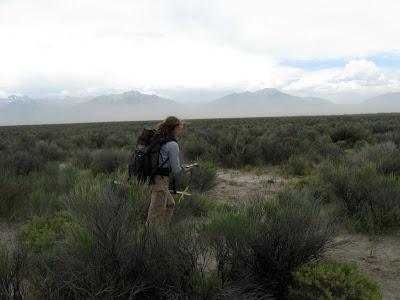 Every state in the U.S. has a Natural Heritage Program (NHP) to comprehensively and systematically monitor biological diversity.
Every state in the U.S. has a Natural Heritage Program (NHP) to comprehensively and systematically monitor biological diversity.
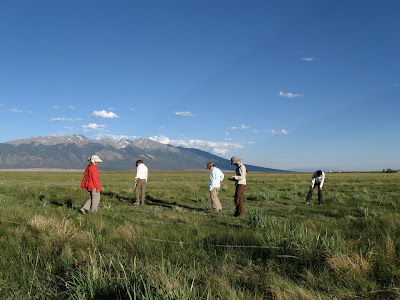 Colorado's NHP GIS computer models select points of special interest based on aerial and satellite imagery. We follow GPS maps to the sample point,
Colorado's NHP GIS computer models select points of special interest based on aerial and satellite imagery. We follow GPS maps to the sample point,
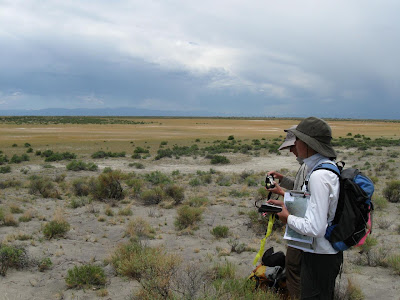 lay out plots to focus our attention at different scales from the microscopic to the landscape.,
lay out plots to focus our attention at different scales from the microscopic to the landscape.,
 collect plant specimens and soil samples as well as analyze ecosystem processes and integrity:
collect plant specimens and soil samples as well as analyze ecosystem processes and integrity:
 Long summer days in the field.
Long summer days in the field.
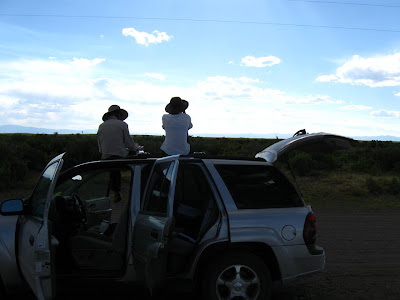
Saturday, June 14, 2008
Exploring the Rio Grande Headwaters: San Luis Valley
The Rio Grande drains the Southern Rocky Mountains and meanders more than 2,000 miles through the desert Southwest before reaching the Caribbean. Spanish explorers followed this river to its headwaters more than 400 years ago.
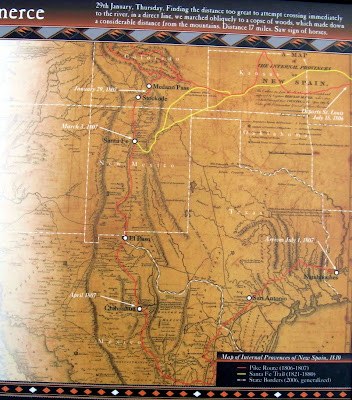 However, the Spanish were notoriously poor scientists, more interested in searching for the Seven Lost Cities of Gold than understanding native ecosystems. Even after the U.S. purchased this area in 1848, and despite more than a hundred years of U.S. exploration and documentation, much of this vast area remains unknown and (relatively) undisturbed by Homo industrialis.
However, the Spanish were notoriously poor scientists, more interested in searching for the Seven Lost Cities of Gold than understanding native ecosystems. Even after the U.S. purchased this area in 1848, and despite more than a hundred years of U.S. exploration and documentation, much of this vast area remains unknown and (relatively) undisturbed by Homo industrialis.
 I've set out this summer with Colorado's Natural Heritage Program to explore the Headwaters of the Rio Grande with a top-notch, interdisciplinary team of scientists from across the country.
I've set out this summer with Colorado's Natural Heritage Program to explore the Headwaters of the Rio Grande with a top-notch, interdisciplinary team of scientists from across the country.
The Rio Grand's headwaters drain from the San Juan Mountains and the Sangre de Christo Mountains into the vast alluvium of the San Luis Valley. This valley, the center of our research, can be thought of as either the southernmost Rocky Mountain park or the northernmost New Mexican valley.
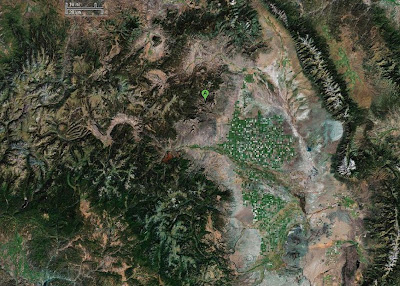 At 7,500 feet this floodplain is a mix of alpine, wetlands, desert, and farmland. Coming from sea level it is continually astonishing to pause and gasp for breath in the center of an agricultural valley where the nearest mountains are 30 miles away. These high plains support a diverse and unique assemblage of plants and animals, with pronghorn antelope feeding in the alfalfa fields, buffalo competing with cows in the sagebrush rangeland, and elk and bear foraging along the periphery.
At 7,500 feet this floodplain is a mix of alpine, wetlands, desert, and farmland. Coming from sea level it is continually astonishing to pause and gasp for breath in the center of an agricultural valley where the nearest mountains are 30 miles away. These high plains support a diverse and unique assemblage of plants and animals, with pronghorn antelope feeding in the alfalfa fields, buffalo competing with cows in the sagebrush rangeland, and elk and bear foraging along the periphery.
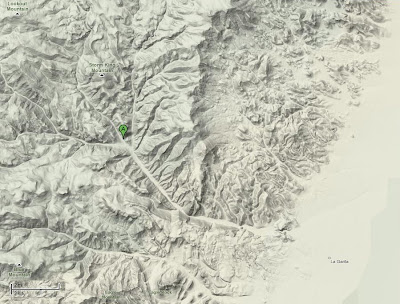 Our HQ is marked on these maps, a swanky cabin safely nestled in an out of the way canyon on the western rim of the valley. To get to this alpine oasis you first drive past the endless center-pivot irrigation systems of San Luis Valley, than upwards past La Garita through Sheep pass, where the rounded granite boulders shelter pinon and juniper. You are now entering Carnero Canyon, whose narrowings and widenings sequentially reveal a lush cottonwood bosque, then Ponderosa woodland and finally Aspen groves and mountain meadows.
Our HQ is marked on these maps, a swanky cabin safely nestled in an out of the way canyon on the western rim of the valley. To get to this alpine oasis you first drive past the endless center-pivot irrigation systems of San Luis Valley, than upwards past La Garita through Sheep pass, where the rounded granite boulders shelter pinon and juniper. You are now entering Carnero Canyon, whose narrowings and widenings sequentially reveal a lush cottonwood bosque, then Ponderosa woodland and finally Aspen groves and mountain meadows.
The "Back 40" (square miles):
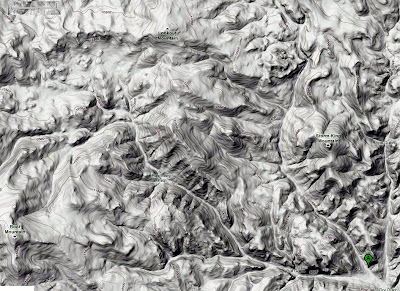
*Since the cabin is off the grid this post was beamed up via satellite.
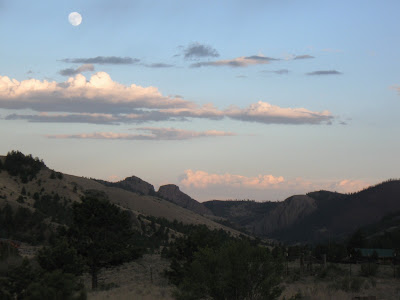
The Rio Grand's headwaters drain from the San Juan Mountains and the Sangre de Christo Mountains into the vast alluvium of the San Luis Valley. This valley, the center of our research, can be thought of as either the southernmost Rocky Mountain park or the northernmost New Mexican valley.
The "Back 40" (square miles):
*Since the cabin is off the grid this post was beamed up via satellite.
Friday, June 13, 2008
Sunday, June 08, 2008
Alaska
Back in the Southwest (of the contiguous United States), land of dusty dry nosebleeds and clockwork sun and stars, time to reflect on Alaskan explorations...
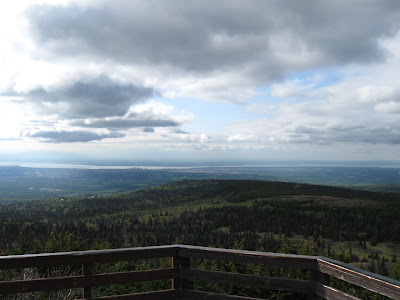 on beyond Anchorage through the Kenai Penninsula....
on beyond Anchorage through the Kenai Penninsula....
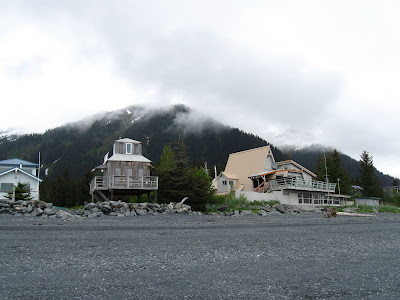 A land of green grass!
A land of green grass!
 When I arrived the dandylions were already blooming and when I left they'd all gone to seed.
When I arrived the dandylions were already blooming and when I left they'd all gone to seed. 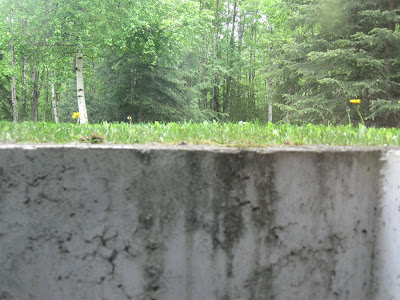 Winter had ended with May, but snow was still at sea level in Prince William Sound.
Winter had ended with May, but snow was still at sea level in Prince William Sound.
Welcome to Alaska!
 I remember the first sunny day of summer, with all Anchorage turned out in force to sunbathe, run, and bike until midnight, when the sun briefly set behind the mountains to the North before rising again at 1:30am.
I remember the first sunny day of summer, with all Anchorage turned out in force to sunbathe, run, and bike until midnight, when the sun briefly set behind the mountains to the North before rising again at 1:30am.
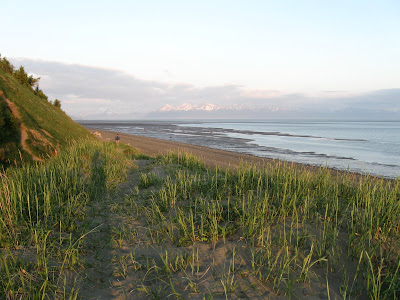
The old man who adumbrated another summerless year, the tourist who complained about "too many hicks and a general sense of wierdness".
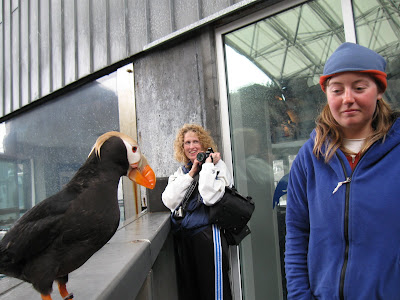 Corinna, my Sackagawea in the land of Mignight sun, the final frontier, full of moose and bears and Giant Cabbage (skunk and otherwise) and pride in all of the above.
Corinna, my Sackagawea in the land of Mignight sun, the final frontier, full of moose and bears and Giant Cabbage (skunk and otherwise) and pride in all of the above.
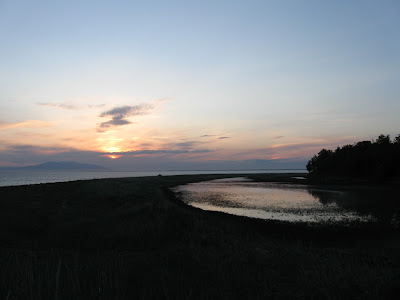 A disturbed landscape, the ecology still recovering from the Great Quake of ''64: the tsunami and land subsidence...
A disturbed landscape, the ecology still recovering from the Great Quake of ''64: the tsunami and land subsidence...
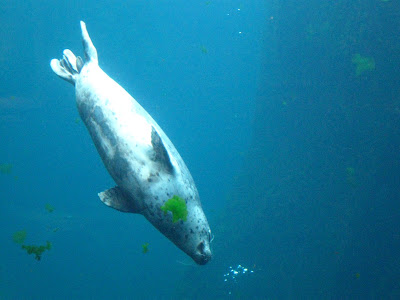 and the Great Oil Spill of '89....
and the Great Oil Spill of '89....
 ...can be hard to believe in the context of awesome, untrammeled, wilderness.
...can be hard to believe in the context of awesome, untrammeled, wilderness.
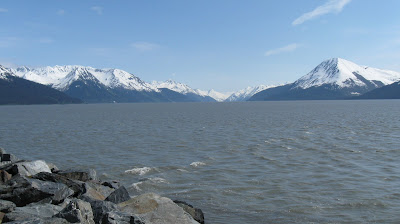 But humans are ubiquitous. My first Alaskan Bear. (the second was flung, unceremoniously, out of a boat onto the beach where Corinna and I were having tea. The bloody carcass was butchered for its skin, paws, and gonads.)
But humans are ubiquitous. My first Alaskan Bear. (the second was flung, unceremoniously, out of a boat onto the beach where Corinna and I were having tea. The bloody carcass was butchered for its skin, paws, and gonads.)

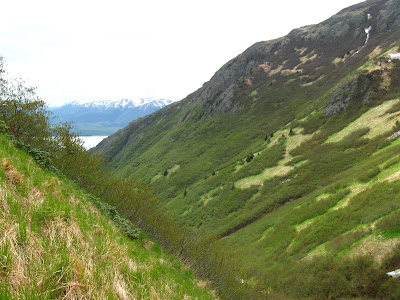
Welcome to Alaska!
The old man who adumbrated another summerless year, the tourist who complained about "too many hicks and a general sense of wierdness".
Saturday, June 07, 2008
Kayaking Prince William Sound'08
Initial report from the Prince William Sound Expedition '08.
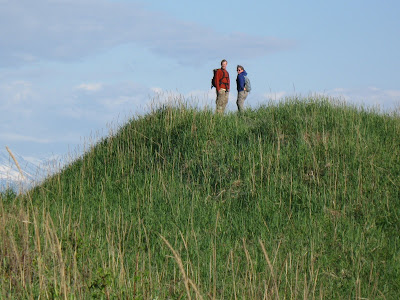 I was pleased and privileged to join in the preparation and adventuring of my good friend Corinna. I jetted to Alaska to drop in on her three month kayak tour of Prince William Sound.
I was pleased and privileged to join in the preparation and adventuring of my good friend Corinna. I jetted to Alaska to drop in on her three month kayak tour of Prince William Sound.
 Chris, another Alaskan native, quit his job to join us, and we were soon joined by a fourth, the recently matriculated Penelope.
Chris, another Alaskan native, quit his job to join us, and we were soon joined by a fourth, the recently matriculated Penelope.
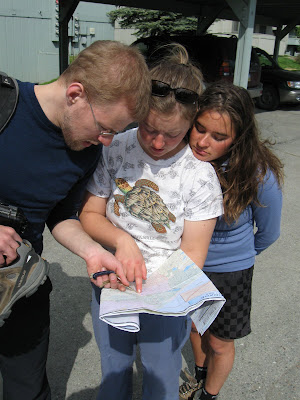 The planning was long and intense, the maps scurrulous, the route difficult, the weather tempestuous, all under a constantly illuminated sky.
The planning was long and intense, the maps scurrulous, the route difficult, the weather tempestuous, all under a constantly illuminated sky.
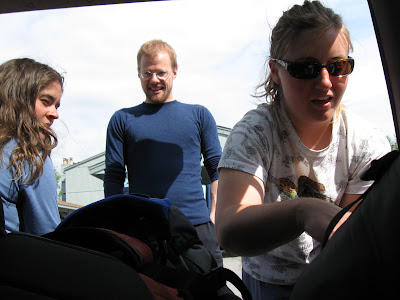 We traveled a route that many have traveled before, but for us, the first time.
We traveled a route that many have traveled before, but for us, the first time.
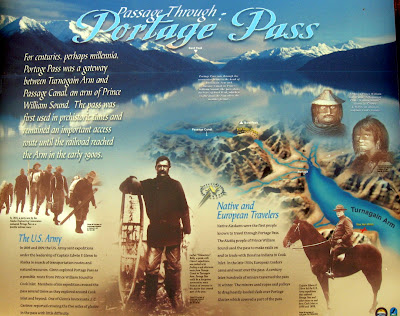 Each walks their own path, even as they travel together.
Each walks their own path, even as they travel together.
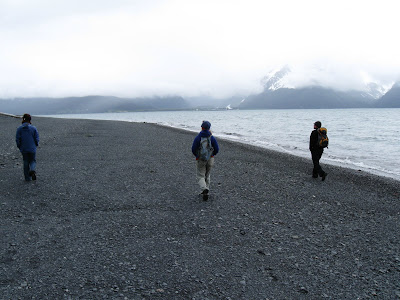 See photos of the trip.
See photos of the trip.
Tuesday, June 03, 2008
Subscribe to:
Posts (Atom)